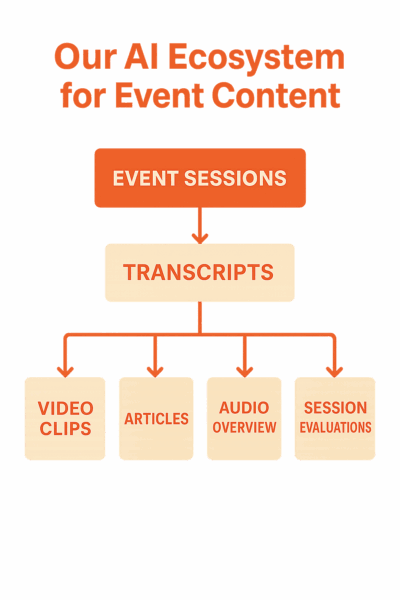How we built an AI ecosystem to amplify our event content
Free and low-cost AI applications helped us atomize and amplify our event content. They can help your team do it too.
According to some estimates, more than half of the content on the internet is now generated by AI. Considering how long it took humans to generate the other half, you’re probably thinking, “That escalated quickly,” and it did.
Among content creators, content marketers and nearly everyone who appreciates quality content and the craftsmanship it requires, a dichotomy is emerging. Content is either “AI slop” or it’s human-generated art.
In truth, that’s never been the case. Humans were creating slop long before generative AI became widely available, and AI can be used to create perfectly good, valuable content. This is an example of the latter.
We built an AI-powered content ecosystem at MarTech to help us amplify content from the September MarTech Conference. Humans were involved in every step along the way. Nothing was published without a human reviewing and editing the content.
But the work — and believe me, atomizing and amplifying content from a conference can be a lot of work — was sped up and simplified, meaning the content reached the audience faster.
Here’s how we did it.
The September MarTech Conference
The September edition of the MarTech Conference took place Sept. 17, 2025. It was a free, online conference consisting of six live panel discussions about data and AI, streamed to registered audience members.
Each conference session had four to five participants, including a moderator.
Transcripts and video clips
The first step in atomizing six panel discussions is to put the content in a form that is easily digestible for other tools. For that, our team turned to Descript, an AI-powered video editing tool.
Descript allowed our team to easily create dozens of short video clips of the conference sessions. More importantly, it generated fast and accurate transcripts of each session, identifying which speaker was speaking along the way.
Throughout the day of the conference, our team created a Google Doc, adding the complete transcript of each conference session shortly after its conclusion. By the end of the day, the document ran nearly 100 pages.

Those transcripts enabled everything that happened next.
The top insights and quotes from the conference
The complete transcripts were exported from Google Docs as a PDF and uploaded to ChatGPT, which was instructed to review the sessions and identify interesting insights and quotes from the panelists.
A human editor reviewed the ChatGPT output and chose the top quotes and top insights that would become content pieces on the MarTech site within days of the conference concluding. We also used the top quotes in a social media carousel format.
ChatGPT also drafted summary articles of the sessions, which were reviewed by human editors and published in the days following the conference.
An audio overview of the conference sessions
We also used Google’s NotebookLM to create an AI-generated audio overview of the event. That overview, which ran 12 minutes long, was embedded in the summary articles published after the conference.
AI-powered session evaluations
Live conferences are stressful. The MarTech Conference sessions were unscripted (though each panel had a planning call beforehand), which means you’re never 100% sure what you’re going to get.
For our events team, we created a Gemini GEM to evaluate the sessions quickly. Once again, the session transcripts were the foundation.
Gemini took the title and description of each session as they appeared on the conference agenda and compared them to the transcript to see how well our content delivered on its promise. It also told us the share of voice for each speaker. Gemini calculated how long each panelist spoke in each session, in both minutes and seconds and as a percentage of the session.
What’s next for this ecosystem?
With the September MarTech Conference, we established a solid playbook for atomizing and amplifying event content. We met our initial expectations, but there are more possibilities to uncover.
One area we plan to explore is connecting some of the AI-generated output to our back-end event management platform. The platform holds the history of MarTech and SMX events going back years — each session, speaker and topic.
By connecting session transcripts and AI-generated evaluations to the system, more information will be available to team members planning future events.
MarTech is owned by Semrush. We remain committed to providing high-quality coverage of marketing topics. Unless otherwise noted, this page’s content was written by either an employee or a paid contractor of Semrush Inc.
Related stories